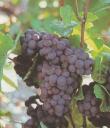Why does a sparkling wine house make a still Pinot Meunier? As a curiousity, or to help wine people teach about varietals? The latter is always my secret theory. It could also be that someone in the winery is freaked-out-in-love with the varietal, seeking to champion it like Paul Draper did with Zinfandel. From what Domaine Chandon says on their website, the grape grows so well for them in Carneros (one of the few places it’s grown other than France), that they just had to make a stand-alone wine from it.
 Pinot Meunier is a red grape that is used to blend into Champagne and sparkling wines, like Pinot Noir is. Most Champagnes, white or rose, are blends, with the exception of Blanc de Blancs, which is made exclusively from Chardonnay. Rose Champagnes, though, are blends of white and rose juice from Chardonnay, Pinot Noir, and Pinot Meunier. It’s generally agreed that Pinot Meunier is a mutation of Pinot Noir, a grand dame of a grape with slutty, mutant ways; Pinot Gris, Pinot Blanc and even Gamay are also thought to be mutations of Matron Momma Noir.
Pinot Meunier is a red grape that is used to blend into Champagne and sparkling wines, like Pinot Noir is. Most Champagnes, white or rose, are blends, with the exception of Blanc de Blancs, which is made exclusively from Chardonnay. Rose Champagnes, though, are blends of white and rose juice from Chardonnay, Pinot Noir, and Pinot Meunier. It’s generally agreed that Pinot Meunier is a mutation of Pinot Noir, a grand dame of a grape with slutty, mutant ways; Pinot Gris, Pinot Blanc and even Gamay are also thought to be mutations of Matron Momma Noir.
The nose on this wine was on the hot side, meaning I could feel the alcohol in it burning my nose. This surprised me, as this wine is from Carneros and therefore should not be prone to over-ripeness, and 2005 was a great, cool year for this region.
 Jammy cane berries and sweet oak were evident on the nose as well, and some spicy notes of clove and nutmeg. (Winespeak Decoder Ring: in wine, “spicy” refers to baking spices, not pepper or chile) There was also an earthy, mushroom-like aroma, evocative of Pinot Noir… almost a tiny whiff of barnyard. (WDR: “barnyard” means it smells, not unpleasently, of manure. Yes, really.)
Jammy cane berries and sweet oak were evident on the nose as well, and some spicy notes of clove and nutmeg. (Winespeak Decoder Ring: in wine, “spicy” refers to baking spices, not pepper or chile) There was also an earthy, mushroom-like aroma, evocative of Pinot Noir… almost a tiny whiff of barnyard. (WDR: “barnyard” means it smells, not unpleasently, of manure. Yes, really.)
Some strawberry and plum on the palate, with a perceptible tannic grip and a clean acidic finish. Not as silky in texture as a Pinot Noir, but soft in my mouth. More structure than fruit on this wine, though; it’s almost Kate Moss with that delicate, strong skeleton and spare flesh. This wine retails for about $30, and while the winery extolls the virtue of their Pinot Meunier’s ability to pair with food, I’m disappointed with the quality, for that price. Evidently, no one else feels this way, as the winery says that they sell out of this wine every year and have even instituted a futures program for it. Alder at Vinography liked the 2001 vintage of this wine. Ah well, that’s just iconoclastic old me, I guess.
Let me clarify; I am a huge fan of Domaine Chandon’s wines. They make impecable sparklers, with excellent price-quality ratio, and very rarely disappoint. They certainly didn’t invent the concept of California bubbly (that distinction goes to Jack and Jamie Davies of Schramsberg), but they were one of the earliest French Champagne houses to get into California, and they make kick-ass wine.
Domaine Chandon bought into the Napa Valley in 1973 and released their first vintage in 1976. They were certainly the first French Champagne house to take the region seriously, making only methode traditionelle sparkling wines (meaning, wines made in the style of Champagne, not by other, cheaper methods), and they were the first winery in California to blend Pinot Meunier into their sparklers.
Anyhow, if you’re a fan of wines made from a blending varietal that’s hard to find much, and you have $30 to invest in your experiment, do try this bottle; I don’t think many other people in Napa are vinifying Pinot Meunier into a still wine. You’ll find a few in Oregon; WillaKenzie does one, as I recall. Beau at Basic Juice liked the Napa Pinot Meunier he sampled. If you’re just looking for a tasty, silky, cheap little red to tickle your tonsils, though, this is not your juice.